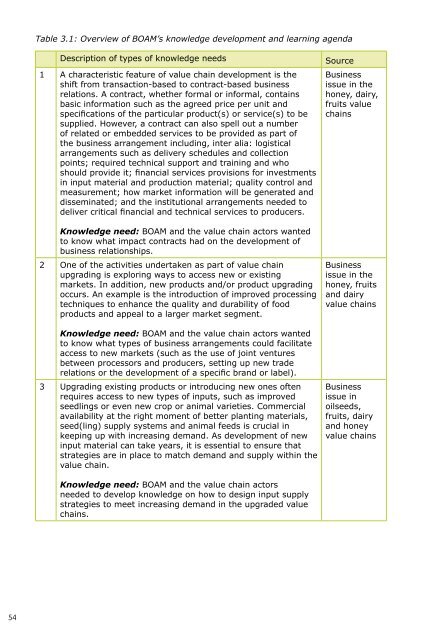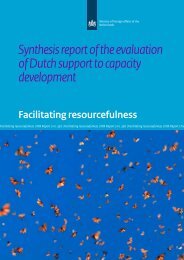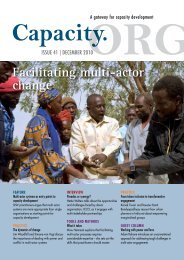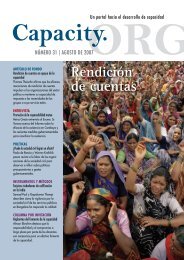Pro-Poor Value Chain Development - Capacity.org
Pro-Poor Value Chain Development - Capacity.org
Pro-Poor Value Chain Development - Capacity.org
Create successful ePaper yourself
Turn your PDF publications into a flip-book with our unique Google optimized e-Paper software.
54<br />
Table 3.1: Overview of BOAM’s knowledge development and learning agenda<br />
Description of types of knowledge needs Source<br />
1 A characteristic feature of value chain development is the<br />
shift from transaction-based to contract-based business<br />
relations. A contract, whether formal or informal, contains<br />
basic information such as the agreed price per unit and<br />
specifications of the particular product(s) or service(s) to be<br />
supplied. However, a contract can also spell out a number<br />
of related or embedded services to be provided as part of<br />
the business arrangement including, inter alia: logistical<br />
arrangements such as delivery schedules and collection<br />
points; required technical support and training and who<br />
should provide it; financial services provisions for investments<br />
in input material and production material; quality control and<br />
measurement; how market information will be generated and<br />
disseminated; and the institutional arrangements needed to<br />
deliver critical financial and technical services to producers.<br />
Knowledge need: BOAM and the value chain actors wanted<br />
to know what impact contracts had on the development of<br />
business relationships.<br />
2 One of the activities undertaken as part of value chain<br />
upgrading is exploring ways to access new or existing<br />
markets. In addition, new products and/or product upgrading<br />
occurs. An example is the introduction of improved processing<br />
techniques to enhance the quality and durability of food<br />
products and appeal to a larger market segment.<br />
Knowledge need: BOAM and the value chain actors wanted<br />
to know what types of business arrangements could facilitate<br />
access to new markets (such as the use of joint ventures<br />
between processors and producers, setting up new trade<br />
relations or the development of a specific brand or label).<br />
3 Upgrading existing products or introducing new ones often<br />
requires access to new types of inputs, such as improved<br />
seedlings or even new crop or animal varieties. Commercial<br />
availability at the right moment of better planting materials,<br />
seed(ling) supply systems and animal feeds is crucial in<br />
keeping up with increasing demand. As development of new<br />
input material can take years, it is essential to ensure that<br />
strategies are in place to match demand and supply within the<br />
value chain.<br />
Knowledge need: BOAM and the value chain actors<br />
needed to develop knowledge on how to design input supply<br />
strategies to meet increasing demand in the upgraded value<br />
chains.<br />
Business<br />
issue in the<br />
honey, dairy,<br />
fruits value<br />
chains<br />
Business<br />
issue in the<br />
honey, fruits<br />
and dairy<br />
value chains<br />
Business<br />
issue in<br />
oilseeds,<br />
fruits, dairy<br />
and honey<br />
value chains













